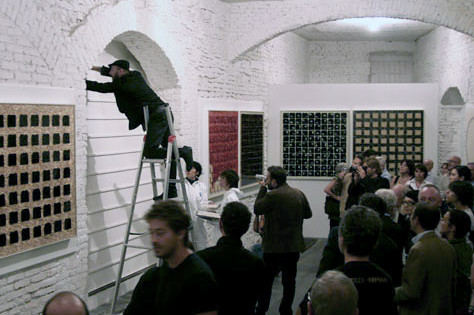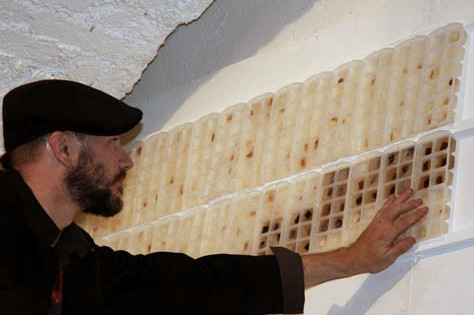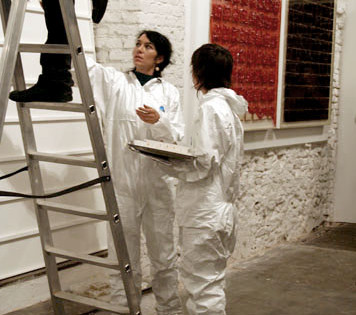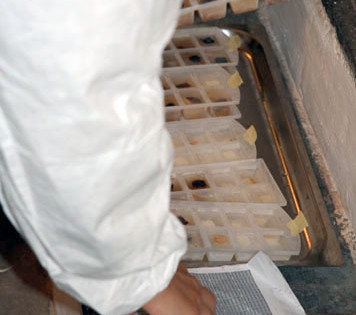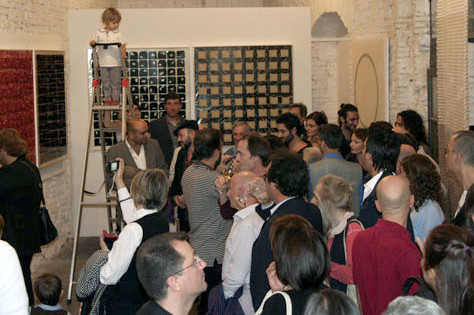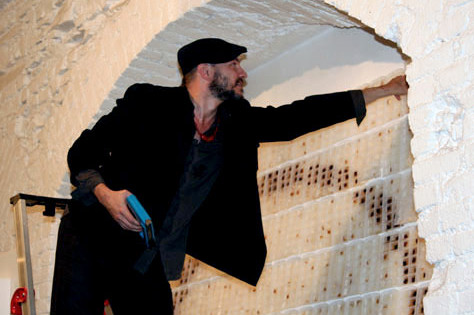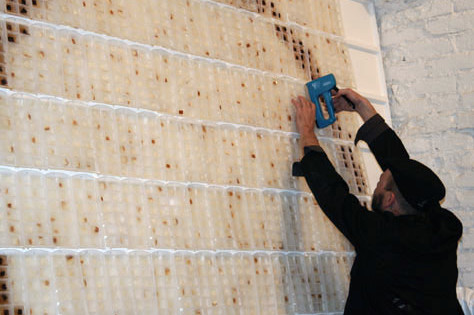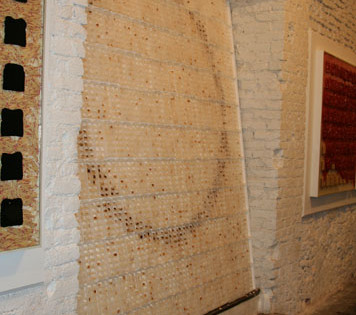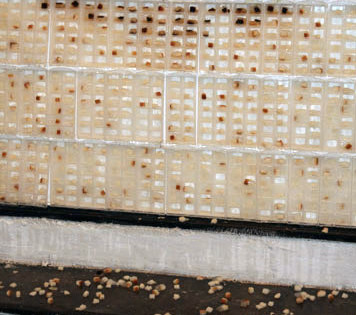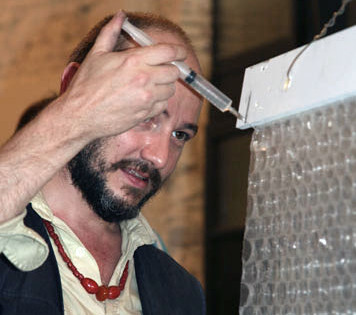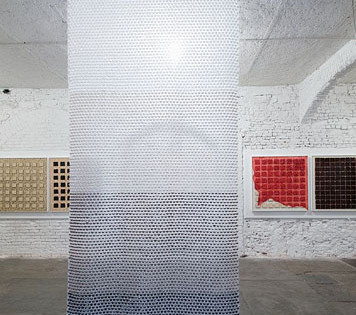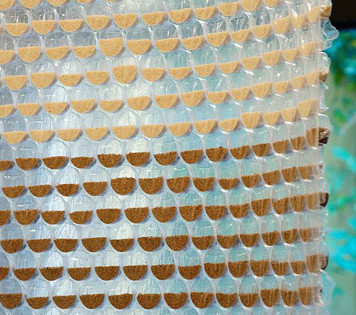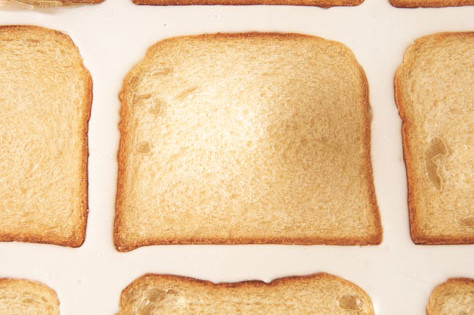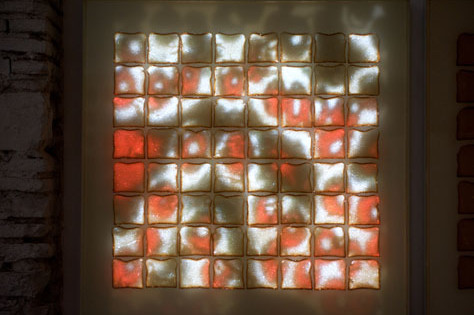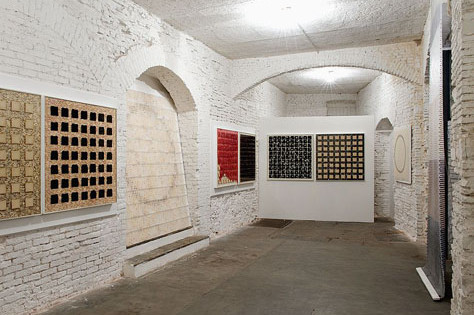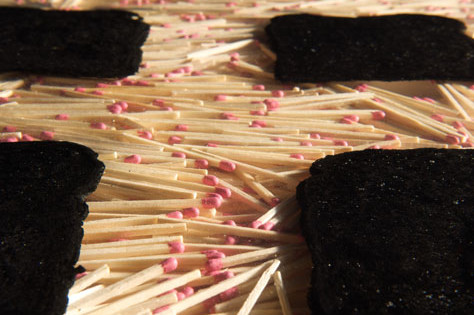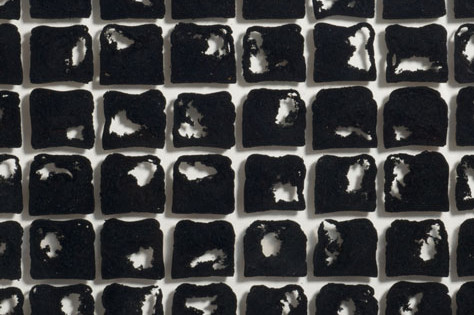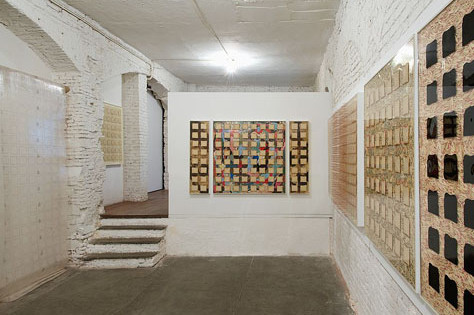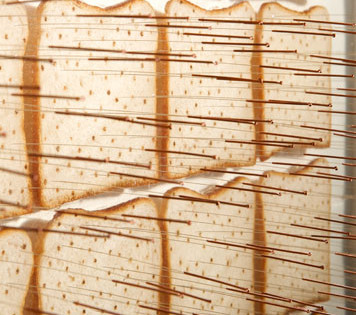DAVID REIMONDO Personale
When speaking of David Reimondo, the temptation “not” to talk about bread would be strong, were it not the same as talking about it in continuation. And perhaps it would not even be right. Better to trace this currently dominant choice back to the realm of linguistic possibilities and (why not?) essential strategies for recognition that an artist puts into play once the humoral, psychological and individual aspects of his own experience have provided him with such an extraordinarily clear and identifiable monogram.
Since the language of art has theoretically taken possession of all the languages and objects of reality, it should not be surprising that someone has taken possession of bread in this sense and, in the specific case of Reimondo, a sliced loaf of bread. An artist takes possession of a color (Klein), a sign (Capogrossi), a certain material (Burri’s jute sacks or Beuys’ fat), a way of writing (Be’s white words on black), a calendar (On Kawara), an instrument (neon), a geometric shape (Albers’ square), a type of architecture (Merz’s igloo), anything that can immediately bring an artist and his art to mind, in the utopian hope of taking possession of an element that reconciles all of reality within it, so that the artist can place his own intellectual copyright on the world. Situated within this mechanism, conscious of being part of a copyright society (only “poor” engineer Kalashnikov, while inventing one of the objects that has most characterized our time, did not receive even one cent, but only a reputation among the famous and infamous…), Reimondo restricted himself in the end to an extremely precise product, albeit one full of symbolic evocation. Perhaps, equally aware that his time is not one of revolutions, when anything can happen, when a person can take possession of the color blue or the square, but rather a time of “variations,” when everything has already been said, but exploration and in-depth study remain open in the margins, the borders, the no man’s lands of language, Reimondo has focused on a single aspect of a broader symbolic world: if Piero Manzoni can still use bread tout court, David Reimondo uses a loaf of bread, sliced and square. Meaning that if, on the one hand, we can still speak of the great theme of the ephemeral, of hunger (for everything, physical as well as knowledge…), of art that consumes itself, today we cannot do as much because that topic has already been codified and possesses its own form such that, at most, as our artist does, we can inquire into that topic by starting with a model that has already been provided: it is the difference that runs between avant-garde – Manzonian – Modernity and entropic Post-modernity, represented in this case by Reimondo. In fact, in addition to choosing bread, he chose an intellectual model and formal ensemble which surpasses the initial model and its intentions long term. Of course, it is also very important for Reimondo that what he speaks of involves the basic element of human life: eating (and which ingredient, at all latitudes, is more representative of this than bread?). In the long run, however, this fundamentality gives way to construction, to the development of the initial subject, until it is on the verge of a kind of wonderful Baroque virtuosity which is, in fact, the exact opposite of its point of departure: it is only possible to make sculptures of bread when you are no longer beset by hunger.
Thus, art makes its rotation: from such a strong element as to overwhelm any other thing, the use of bread becomes, with the custom of prolonged and exclusive use, a form, the minimum element on which to construct your alphabet, your syntax, your stories. It is thus not by chance that Reimondo chose the square (bread) for his own story of the world: it is an ideal geometric form, versatile but tidy and modular, serious, strong, and even sensible. Its composition is ensured, its vision organized, the horizon remains, despite everything, in its place.
However, with the intuition of a true artist and the wisdom of a master carpenter – or a first-rate chef – with bread Reimondo introduced a disturbing element into his work, no longer the revolutionary component of Modernity, hungry once again, so much as the extravagance of the material, the heterodoxy of having already seen everything, the stimulus of a Byzantine intelligence that nonetheless, in the remote mazes of memory, or even in some part of the double helix of life, preserves a distant recollection of that thing called “bread.” The use of the square slice of bread or, better, the use of bread to make a square, becomes a sort of surplus of meaning, a kind of boost, a temporary injection of energy to heighten the work’s driving power. In this way we recall that mind-set of the art spectator (“…and, just think – they will say – it is made of bread!”) that is never satiated: respect and admiration for a technical/craftsman-like skill that, on the contrary, the artist almost always pushes aside, when he does not actually disdain it.
But then – someone could object at this point – did Reimondo do nothing more than cynically put shock into play, an element that he knew would catalyze the gaze and immediately make him stand out in the crowd of artists? Although this position is legitimate – and useful – the answer is nevertheless negative, because Reimondo did not choose bread from the middle of a repertoire, an improbable list of materials that could be used to amaze and to become “someone,” but rather found in that bread a satisfactory answer to his expressive needs, which are born and grow unchecked, at least until they are transformed into coherent language. So the artist always verifies the expressive possibilities of an idea, an intuition, even a whim, in the field – meaning in the work itself – and if these withstand the test of object fulfillment, he will carry them along with him until they have been exhausted. Reimondo has done so with sliced bread, and we can nonetheless detect variations, transformations and changes, even quite considerable ones, over the course of the few years during which bread seems to be his protagonist: it shifts, for example, from a strongly narrative vocation, almost a splatter of self-consuming human figures rending their chests, eating the material of which they are made, to a near abstraction composed of bread as a repeated form, as a surface, as a pure material capable of retaining a mark, passing through revealing performative actions. But before even looking at this evolution in the use of bread, it is necessary to resolve once and for all the question of its expressive importance, which still forms the basis of the work. Reimondo certainly found in bread of that shape a tool that is very close to his mentality, which simultaneously involves the organic with the symbolic, with construction and narration: organic par excellence, bread is one of the objects most subject to metaphors and symbols, but it is also an excellent constructive form which can even provide a basis for construction – to the letter – of complex narration (see, for example, the scenes with three-dimensional human figures of a few years ago). In our opinion, the driving priority of the choice goes back to the concept of the organic, to that material that is delicate and perishable, but alive, good, full of energy. It is the natural obsession with transience that makes him seek – and find – the method to immobilize for eternity, in the transparent resin that spreads over all of his compositions, that organic nature of life that is so fragile and so transient; at the same time, however, the design that he impresses on it changes the quality of that material in substance, the burning changes its molecular composition and, still, the organic superimposes the organic, and the vitalistic awe of finding seeds usable in the Egyptian pyramids is renewed in the rite of the crumbs of bread that Reimondo inserts one by one – organic in inorganic, natural in artificial – within the plastic bubbles of the packaging casings, or imprisoned in ice. To rebuild a whole world starting with the inexorable metamorphosis of the organic seems to have been the main intention of his work, at least until a few months ago, when the exact superimposition between material and narrative material – for example a man made of bread – started to give way to more abstract compositions, where the organic still overlaps the organic – bread arranged in regular rows on rags, hair, wood – and then to drawing, namely pure and simple “representation,” the task of constructing his own imagery. All of it is always organic, but now the hair is drawn (burned) onto the bread, like mould. Finally the maps appeared, the inevitable result of a special layout that is already a map in itself, a subdivision for full and empty blocks. The symbolic value of bread is now a memory, present but increasingly subtle, increasingly impalpable, so that at this point in the adventure of David Reimondo bread can leave us just as well as remain with us. That which will never leave us is the conceptual copyright that he has conquered.
________________________________________________________________________
David Reimondo – COPYRIGHT
Testo di Marco Meneguzzo
A proposito di David Reimondo, la tentazione di “non” parlare di pane sarebbe forte, se non fosse la stessa cosa che parlarne in continuazione. E forse non sarebbe neanche giusto. Meglio ricondurre questa scelta (per ora) totalizzante nell’ambito delle possibilità linguistiche e, perché no, delle indispensabili strategie di riconoscibilità che un artista mette in campo, una volta che gli aspetti umorali, psicologici, individuali, del proprio vissuto gli hanno fornito una cifra così straordinariamente chiara e individuabile.
Da quando il linguaggio dell’arte si è appropriato, teoricamente, di tutti i linguaggi e gli oggetti della realtà, non deve risultare stupefacente che qualcuno si appropri in tal senso del pane, nella ristretta fattispecie del pane in cassetta affettato come fa Reimondo. Ci si appropria di un colore – Klein -, di un segno – Capogrossi – di una materia – il sacco di juta di Burri o il grasso di Beuys -, di un modo di scrivere – le parole bianche su nero di Ben -, di un calendario – On Kawara -, di uno strumento – il neon -, di una forma geometrica – il quadrato di Albers -, di un’architettura – l’igloo di Merz -, di tutto quanto possa immediatamente ricondurre la mente a un artista e alla sua arte, nell’attesa utopica di riuscire ad appropriarsi di un elemento che contemperi in sé tutto il reale, in modo da poter apporre il proprio copyright intellettuale sul mondo. Inserito in questo meccanismo, cosciente di far parte di una società del copyright (solo il “povero” ingegner Kalashnikov, pur inventando uno degli oggetti che più hanno caratterizzato la nostra epoca, non ne ha ricavato neppure un centesimo, ma solo una notorietà tra il famoso e il famigerato…), Reimondo si è in fondo limitato a un prodotto estremamente preciso, per quanto carico di evocazioni simboliche. Forse, altrettanto cosciente che la sua epoca non è quella delle rivoluzioni, quando tutto può accadere, quando qualcuno si può appropriare del blu o del quadrato, ma è piuttosto l’epoca delle “varianti”, quando tutto è già stato detto, ma rimane aperta l’esplorazione e l’approfondimento dei margini, dei confini, dei territori di nessuno del linguaggio, Reimondo si è concentrato su un solo aspetto di un più vasto mondo simbolico: se Piero Manzoni può ancora utilizzare il pane tout court, David Reimondo utilizza il pane a cassetta, affettato, quadrato. Se, cioè, da un lato si può ancora parlare del grande tema dell’effimero, della fame (di tutto, fisica come di conoscenza…), dell’arte che consuma se stessa, oggi non si può fare altrettanto, perché quell’argomento è stato ormai codificato, e possiede una sua forma, per cui al massimo, come fa il nostro artista, si può indagare quel tema a partire da un modello già dato: è la differenza che corre tra la Modernità avanguardistica – manzoniana – e la Postmodernità entropica, in questo caso rappresentata da Reimondo. Egli, di fatto, oltre a scegliere il pane, ha scelto un modulo intellettuale e insieme formale, che alla lunga sopravanza il modello iniziale e le sue intenzioni. Certo, anche per Reimondo è importantissimo che ciò di cui si parla abbia a che fare con l’elemento-base della vita umana, il mangiare ( e quale ingrediente, sotto tutte le latitudini, è più rappresentativo di questo del pane?…), ma poi, a lungo andare, questa elementarità lascia il passo alla costruzione, all’elaborazione del primo soggetto, sin quasi a sfiorare una sorta di meraviglioso virtuosismo barocco che, di fatto, è il contrario esatto di quel punto di partenza: si possono fare sculture di pane solo quando per te non esiste più il problema di essere affamato.
Così, l’arte fa il suo giro: da elemento tanto forte da diventare soverchiante su ogni altra cosa, l’utilizzo del pane diventa, con la consuetudine di un uso prolungato ed esclusivo, un modulo, l’elemento minimo su cui costruire il proprio alfabeto, la propria sintassi, i propri racconti. Non è un caso, allora, che Reimondo abbia scelto il (pane) quadrato per la propria storia del mondo: è un modulo geometrico ideale, duttile ma composto e componibile, serio, robusto, “quadrato”, appunto. La composizione è assicurata, la visione è organizzata, l’orizzonte resta, nonostante tutto, al suo posto.
Però, con l’intuizione di un vero artista e la sapienza consumata di un maestro d’ascia – o di un cuoco sopraffino -, Reimondo col pane ha introdotto nell’opera l’elemento perturbante, che non è più il fattore rivoluzionario della Modernità affamata di nuovo, quanto la stravaganza della materia, l’eterodossia dell’aver già visto tutto, il solleticamento di un’intelligenza bizantina che tuttavia, nei remoti meandri della memoria, o addirittura in qualche parte della doppia elica della vita, conserva una lontana reminiscenza di quella cosa chiamata “pane”. L’uso del quadrato di pane o, meglio, l’uso del pane per fare il quadrato, diventa una sorta di surplus di significato, una specie di boost, di iniezione temporanea di energia per aumentare la potenza propulsiva dell’opera:”… e, pensa – si dirà – è fatta di pane!”, a ricordare quell’attitudine mai sopita nello spettatore di opere d’arte, che è il rispetto e l’ammirazione per una capacità tecnico-artigianale che, al contrario, l’artista quasi sempre pone in secondo piano, quando addirittura non la disprezza.
Ma allora – potrebbe obiettare qualcuno a questo punto – Reimondo non ha fatto altro che mettere cinicamente in campo lo stupore, un elemento che sapeva avrebbe catalizzato lo sguardo e lo avrebbe immediatamente fatto uscire dalla folla degli altri artisti? A parte la legittimità – e l’utilità – di questa posizione, la risposta è comunque negativa, perché Reimondo non ha scelto il pane in mezzo a un repertorio, a una improbabile lista dei materiali usabili per stupire e “diventare qualcuno”, ma ha trovato in quel pane una risposta soddisfacente ai suoi bisogni espressivi, i quali nascono e crescono incontrollati, almeno sino a quando non si trasformano in linguaggio coerente. Così, l’artista verifica sempre, sul campo – cioè nell’opera – , le possibilità espressive di un’idea, di un’intuizione, persino di un capriccio, e se queste reggono alla prova della realizzazione oggettuale, se le porta dietro sino a quando non si esauriscono. Così Reimondo ha fatto col pane a cassetta, dove, comunque, si riconoscono variazioni, trasformazioni, mutamenti anche notevoli nel corso dei pochi anni durante i quali il pane sembra essere protagonista: si passa per esempio da una vocazione fortemente narrativa e quasi splatter delle figure umane autofage, che si lacerano il petto, che mangiano quel materiale di cui sono fatte, alla quasi astrazione composta dal pane inteso come modulo ripetuto, come superficie, come pura materia atta ad accogliere un segno, passando per delle azioni performative rivelatrici. Ma prima ancora di guardare all’evoluzione nell’uso del pane, va risolta una volta per tutte la questione della sua importanza espressiva, che sta comunque alla base del lavoro. Sicuramente Reimondo ha trovato nel pane di quella foggia uno strumento molto vicino al proprio sentire, che ha contemporaneamente a che fare con l’organico, col simbolico, con la costruzione e con la narrazione: organico per eccellenza, il pane è uno degli oggetti più passibili di metafore e di simboli, ma è anche un modulo costruttivo eccellente, che può costituire la base per la costruzione – alla lettera – di narrazioni anche complesse (si vedano ad esempio le scene con le figure umane tridimensionali di qualche anno fa). La priorità pulsionale della scelta va, a nostro avviso, al concetto di organico, a quella materia, cioè, delicata, deperibile, ma viva, buona, piena di energia. E’ la naturale ossessione della caducità che gli fa cercare – e trovare – il metodo per immobilizzare per l’eternità, nella resina trasparente che stende su ogni sua composizione, quell’organicità della vita così fragile, così caduca, ma allo stesso tempo il disegno che vi imprime sopra cambia nella sostanza la qualità di quel materiale, che nella bruciatura modifica la propria composizione molecolare e, ancora, l’organico si sovrappone all’organico, e lo stupore vitalistico di ritrovare semi utilizzabili nelle piramidi egiziane si rinnova nel rito delle briciole di pane che Reimondo inserisce una ad una – organico nell’inorganico, naturale nell’artificiale – all’interno delle bolle di plastica degli involucri da imballaggio, o imprigiona nel ghiaccio. Ricostruire tutto un mondo a partire dalle inesorabili metamorfosi dell’organico sembra essere stata l’intenzione principale del suo lavoro, almeno sino a pochi mesi fa, quando la sovrapposizione esatta tra materia e materia narrativa – ad esempio l’uomo fatto di pane – ha cominciato a lasciare il passo a composizioni più astratte, dove l’organico si sovrappone comunque all’organico – il pane disposto in file regolari sugli stracci, sui capelli, sul legno -, per poi lasciare al disegno, cioè alla “rappresentazione” pura e semplice, il compito di costruire il proprio immaginario. E’ tutto sempre organico, ma ora i capelli sono disegnati (bruciati) sul pane, come le muffe, e infine sono comparse le mappe, conseguenza inevitabile di una disposizione spaziale che è già di per sé una mappa, una suddivisione per blocchi di pieni e di vuoti. Il valore simbolico del pane è adesso un ricordo, presente ma sempre più sottile, sempre più impalpabile, tanto che a questo punto dell’avventura di David Reimondo il pane ci può lasciare, come può restare. Ciò che non verrà mai meno è il copyright ideale che si è conquistato.
Since the language of art has theoretically taken possession of all the languages and objects of reality, it should not be surprising that someone has taken possession of bread in this sense and, in the specific case of Reimondo, a sliced loaf of bread. An artist takes possession of a color (Klein), a sign (Capogrossi), a certain material (Burri’s jute sacks or Beuys’ fat), a way of writing (Be’s white words on black), a calendar (On Kawara), an instrument (neon), a geometric shape (Albers’ square), a type of architecture (Merz’s igloo), anything that can immediately bring an artist and his art to mind, in the utopian hope of taking possession of an element that reconciles all of reality within it, so that the artist can place his own intellectual copyright on the world. Situated within this mechanism, conscious of being part of a copyright society (only “poor” engineer Kalashnikov, while inventing one of the objects that has most characterized our time, did not receive even one cent, but only a reputation among the famous and infamous…), Reimondo restricted himself in the end to an extremely precise product, albeit one full of symbolic evocation. Perhaps, equally aware that his time is not one of revolutions, when anything can happen, when a person can take possession of the color blue or the square, but rather a time of “variations,” when everything has already been said, but exploration and in-depth study remain open in the margins, the borders, the no man’s lands of language, Reimondo has focused on a single aspect of a broader symbolic world: if Piero Manzoni can still use bread tout court, David Reimondo uses a loaf of bread, sliced and square. Meaning that if, on the one hand, we can still speak of the great theme of the ephemeral, of hunger (for everything, physical as well as knowledge…), of art that consumes itself, today we cannot do as much because that topic has already been codified and possesses its own form such that, at most, as our artist does, we can inquire into that topic by starting with a model that has already been provided: it is the difference that runs between avant-garde – Manzonian – Modernity and entropic Post-modernity, represented in this case by Reimondo. In fact, in addition to choosing bread, he chose an intellectual model and formal ensemble which surpasses the initial model and its intentions long term. Of course, it is also very important for Reimondo that what he speaks of involves the basic element of human life: eating (and which ingredient, at all latitudes, is more representative of this than bread?). In the long run, however, this fundamentality gives way to construction, to the development of the initial subject, until it is on the verge of a kind of wonderful Baroque virtuosity which is, in fact, the exact opposite of its point of departure: it is only possible to make sculptures of bread when you are no longer beset by hunger.
Thus, art makes its rotation: from such a strong element as to overwhelm any other thing, the use of bread becomes, with the custom of prolonged and exclusive use, a form, the minimum element on which to construct your alphabet, your syntax, your stories. It is thus not by chance that Reimondo chose the square (bread) for his own story of the world: it is an ideal geometric form, versatile but tidy and modular, serious, strong, and even sensible. Its composition is ensured, its vision organized, the horizon remains, despite everything, in its place.
However, with the intuition of a true artist and the wisdom of a master carpenter – or a first-rate chef – with bread Reimondo introduced a disturbing element into his work, no longer the revolutionary component of Modernity, hungry once again, so much as the extravagance of the material, the heterodoxy of having already seen everything, the stimulus of a Byzantine intelligence that nonetheless, in the remote mazes of memory, or even in some part of the double helix of life, preserves a distant recollection of that thing called “bread.” The use of the square slice of bread or, better, the use of bread to make a square, becomes a sort of surplus of meaning, a kind of boost, a temporary injection of energy to heighten the work’s driving power. In this way we recall that mind-set of the art spectator (“…and, just think – they will say – it is made of bread!”) that is never satiated: respect and admiration for a technical/craftsman-like skill that, on the contrary, the artist almost always pushes aside, when he does not actually disdain it.
But then – someone could object at this point – did Reimondo do nothing more than cynically put shock into play, an element that he knew would catalyze the gaze and immediately make him stand out in the crowd of artists? Although this position is legitimate – and useful – the answer is nevertheless negative, because Reimondo did not choose bread from the middle of a repertoire, an improbable list of materials that could be used to amaze and to become “someone,” but rather found in that bread a satisfactory answer to his expressive needs, which are born and grow unchecked, at least until they are transformed into coherent language. So the artist always verifies the expressive possibilities of an idea, an intuition, even a whim, in the field – meaning in the work itself – and if these withstand the test of object fulfillment, he will carry them along with him until they have been exhausted. Reimondo has done so with sliced bread, and we can nonetheless detect variations, transformations and changes, even quite considerable ones, over the course of the few years during which bread seems to be his protagonist: it shifts, for example, from a strongly narrative vocation, almost a splatter of self-consuming human figures rending their chests, eating the material of which they are made, to a near abstraction composed of bread as a repeated form, as a surface, as a pure material capable of retaining a mark, passing through revealing performative actions. But before even looking at this evolution in the use of bread, it is necessary to resolve once and for all the question of its expressive importance, which still forms the basis of the work. Reimondo certainly found in bread of that shape a tool that is very close to his mentality, which simultaneously involves the organic with the symbolic, with construction and narration: organic par excellence, bread is one of the objects most subject to metaphors and symbols, but it is also an excellent constructive form which can even provide a basis for construction – to the letter – of complex narration (see, for example, the scenes with three-dimensional human figures of a few years ago). In our opinion, the driving priority of the choice goes back to the concept of the organic, to that material that is delicate and perishable, but alive, good, full of energy. It is the natural obsession with transience that makes him seek – and find – the method to immobilize for eternity, in the transparent resin that spreads over all of his compositions, that organic nature of life that is so fragile and so transient; at the same time, however, the design that he impresses on it changes the quality of that material in substance, the burning changes its molecular composition and, still, the organic superimposes the organic, and the vitalistic awe of finding seeds usable in the Egyptian pyramids is renewed in the rite of the crumbs of bread that Reimondo inserts one by one – organic in inorganic, natural in artificial – within the plastic bubbles of the packaging casings, or imprisoned in ice. To rebuild a whole world starting with the inexorable metamorphosis of the organic seems to have been the main intention of his work, at least until a few months ago, when the exact superimposition between material and narrative material – for example a man made of bread – started to give way to more abstract compositions, where the organic still overlaps the organic – bread arranged in regular rows on rags, hair, wood – and then to drawing, namely pure and simple “representation,” the task of constructing his own imagery. All of it is always organic, but now the hair is drawn (burned) onto the bread, like mould. Finally the maps appeared, the inevitable result of a special layout that is already a map in itself, a subdivision for full and empty blocks. The symbolic value of bread is now a memory, present but increasingly subtle, increasingly impalpable, so that at this point in the adventure of David Reimondo bread can leave us just as well as remain with us. That which will never leave us is the conceptual copyright that he has conquered.
________________________________________________________________________
David Reimondo – COPYRIGHT
Testo di Marco Meneguzzo
A proposito di David Reimondo, la tentazione di “non” parlare di pane sarebbe forte, se non fosse la stessa cosa che parlarne in continuazione. E forse non sarebbe neanche giusto. Meglio ricondurre questa scelta (per ora) totalizzante nell’ambito delle possibilità linguistiche e, perché no, delle indispensabili strategie di riconoscibilità che un artista mette in campo, una volta che gli aspetti umorali, psicologici, individuali, del proprio vissuto gli hanno fornito una cifra così straordinariamente chiara e individuabile.
Da quando il linguaggio dell’arte si è appropriato, teoricamente, di tutti i linguaggi e gli oggetti della realtà, non deve risultare stupefacente che qualcuno si appropri in tal senso del pane, nella ristretta fattispecie del pane in cassetta affettato come fa Reimondo. Ci si appropria di un colore – Klein -, di un segno – Capogrossi – di una materia – il sacco di juta di Burri o il grasso di Beuys -, di un modo di scrivere – le parole bianche su nero di Ben -, di un calendario – On Kawara -, di uno strumento – il neon -, di una forma geometrica – il quadrato di Albers -, di un’architettura – l’igloo di Merz -, di tutto quanto possa immediatamente ricondurre la mente a un artista e alla sua arte, nell’attesa utopica di riuscire ad appropriarsi di un elemento che contemperi in sé tutto il reale, in modo da poter apporre il proprio copyright intellettuale sul mondo. Inserito in questo meccanismo, cosciente di far parte di una società del copyright (solo il “povero” ingegner Kalashnikov, pur inventando uno degli oggetti che più hanno caratterizzato la nostra epoca, non ne ha ricavato neppure un centesimo, ma solo una notorietà tra il famoso e il famigerato…), Reimondo si è in fondo limitato a un prodotto estremamente preciso, per quanto carico di evocazioni simboliche. Forse, altrettanto cosciente che la sua epoca non è quella delle rivoluzioni, quando tutto può accadere, quando qualcuno si può appropriare del blu o del quadrato, ma è piuttosto l’epoca delle “varianti”, quando tutto è già stato detto, ma rimane aperta l’esplorazione e l’approfondimento dei margini, dei confini, dei territori di nessuno del linguaggio, Reimondo si è concentrato su un solo aspetto di un più vasto mondo simbolico: se Piero Manzoni può ancora utilizzare il pane tout court, David Reimondo utilizza il pane a cassetta, affettato, quadrato. Se, cioè, da un lato si può ancora parlare del grande tema dell’effimero, della fame (di tutto, fisica come di conoscenza…), dell’arte che consuma se stessa, oggi non si può fare altrettanto, perché quell’argomento è stato ormai codificato, e possiede una sua forma, per cui al massimo, come fa il nostro artista, si può indagare quel tema a partire da un modello già dato: è la differenza che corre tra la Modernità avanguardistica – manzoniana – e la Postmodernità entropica, in questo caso rappresentata da Reimondo. Egli, di fatto, oltre a scegliere il pane, ha scelto un modulo intellettuale e insieme formale, che alla lunga sopravanza il modello iniziale e le sue intenzioni. Certo, anche per Reimondo è importantissimo che ciò di cui si parla abbia a che fare con l’elemento-base della vita umana, il mangiare ( e quale ingrediente, sotto tutte le latitudini, è più rappresentativo di questo del pane?…), ma poi, a lungo andare, questa elementarità lascia il passo alla costruzione, all’elaborazione del primo soggetto, sin quasi a sfiorare una sorta di meraviglioso virtuosismo barocco che, di fatto, è il contrario esatto di quel punto di partenza: si possono fare sculture di pane solo quando per te non esiste più il problema di essere affamato.
Così, l’arte fa il suo giro: da elemento tanto forte da diventare soverchiante su ogni altra cosa, l’utilizzo del pane diventa, con la consuetudine di un uso prolungato ed esclusivo, un modulo, l’elemento minimo su cui costruire il proprio alfabeto, la propria sintassi, i propri racconti. Non è un caso, allora, che Reimondo abbia scelto il (pane) quadrato per la propria storia del mondo: è un modulo geometrico ideale, duttile ma composto e componibile, serio, robusto, “quadrato”, appunto. La composizione è assicurata, la visione è organizzata, l’orizzonte resta, nonostante tutto, al suo posto.
Però, con l’intuizione di un vero artista e la sapienza consumata di un maestro d’ascia – o di un cuoco sopraffino -, Reimondo col pane ha introdotto nell’opera l’elemento perturbante, che non è più il fattore rivoluzionario della Modernità affamata di nuovo, quanto la stravaganza della materia, l’eterodossia dell’aver già visto tutto, il solleticamento di un’intelligenza bizantina che tuttavia, nei remoti meandri della memoria, o addirittura in qualche parte della doppia elica della vita, conserva una lontana reminiscenza di quella cosa chiamata “pane”. L’uso del quadrato di pane o, meglio, l’uso del pane per fare il quadrato, diventa una sorta di surplus di significato, una specie di boost, di iniezione temporanea di energia per aumentare la potenza propulsiva dell’opera:”… e, pensa – si dirà – è fatta di pane!”, a ricordare quell’attitudine mai sopita nello spettatore di opere d’arte, che è il rispetto e l’ammirazione per una capacità tecnico-artigianale che, al contrario, l’artista quasi sempre pone in secondo piano, quando addirittura non la disprezza.
Ma allora – potrebbe obiettare qualcuno a questo punto – Reimondo non ha fatto altro che mettere cinicamente in campo lo stupore, un elemento che sapeva avrebbe catalizzato lo sguardo e lo avrebbe immediatamente fatto uscire dalla folla degli altri artisti? A parte la legittimità – e l’utilità – di questa posizione, la risposta è comunque negativa, perché Reimondo non ha scelto il pane in mezzo a un repertorio, a una improbabile lista dei materiali usabili per stupire e “diventare qualcuno”, ma ha trovato in quel pane una risposta soddisfacente ai suoi bisogni espressivi, i quali nascono e crescono incontrollati, almeno sino a quando non si trasformano in linguaggio coerente. Così, l’artista verifica sempre, sul campo – cioè nell’opera – , le possibilità espressive di un’idea, di un’intuizione, persino di un capriccio, e se queste reggono alla prova della realizzazione oggettuale, se le porta dietro sino a quando non si esauriscono. Così Reimondo ha fatto col pane a cassetta, dove, comunque, si riconoscono variazioni, trasformazioni, mutamenti anche notevoli nel corso dei pochi anni durante i quali il pane sembra essere protagonista: si passa per esempio da una vocazione fortemente narrativa e quasi splatter delle figure umane autofage, che si lacerano il petto, che mangiano quel materiale di cui sono fatte, alla quasi astrazione composta dal pane inteso come modulo ripetuto, come superficie, come pura materia atta ad accogliere un segno, passando per delle azioni performative rivelatrici. Ma prima ancora di guardare all’evoluzione nell’uso del pane, va risolta una volta per tutte la questione della sua importanza espressiva, che sta comunque alla base del lavoro. Sicuramente Reimondo ha trovato nel pane di quella foggia uno strumento molto vicino al proprio sentire, che ha contemporaneamente a che fare con l’organico, col simbolico, con la costruzione e con la narrazione: organico per eccellenza, il pane è uno degli oggetti più passibili di metafore e di simboli, ma è anche un modulo costruttivo eccellente, che può costituire la base per la costruzione – alla lettera – di narrazioni anche complesse (si vedano ad esempio le scene con le figure umane tridimensionali di qualche anno fa). La priorità pulsionale della scelta va, a nostro avviso, al concetto di organico, a quella materia, cioè, delicata, deperibile, ma viva, buona, piena di energia. E’ la naturale ossessione della caducità che gli fa cercare – e trovare – il metodo per immobilizzare per l’eternità, nella resina trasparente che stende su ogni sua composizione, quell’organicità della vita così fragile, così caduca, ma allo stesso tempo il disegno che vi imprime sopra cambia nella sostanza la qualità di quel materiale, che nella bruciatura modifica la propria composizione molecolare e, ancora, l’organico si sovrappone all’organico, e lo stupore vitalistico di ritrovare semi utilizzabili nelle piramidi egiziane si rinnova nel rito delle briciole di pane che Reimondo inserisce una ad una – organico nell’inorganico, naturale nell’artificiale – all’interno delle bolle di plastica degli involucri da imballaggio, o imprigiona nel ghiaccio. Ricostruire tutto un mondo a partire dalle inesorabili metamorfosi dell’organico sembra essere stata l’intenzione principale del suo lavoro, almeno sino a pochi mesi fa, quando la sovrapposizione esatta tra materia e materia narrativa – ad esempio l’uomo fatto di pane – ha cominciato a lasciare il passo a composizioni più astratte, dove l’organico si sovrappone comunque all’organico – il pane disposto in file regolari sugli stracci, sui capelli, sul legno -, per poi lasciare al disegno, cioè alla “rappresentazione” pura e semplice, il compito di costruire il proprio immaginario. E’ tutto sempre organico, ma ora i capelli sono disegnati (bruciati) sul pane, come le muffe, e infine sono comparse le mappe, conseguenza inevitabile di una disposizione spaziale che è già di per sé una mappa, una suddivisione per blocchi di pieni e di vuoti. Il valore simbolico del pane è adesso un ricordo, presente ma sempre più sottile, sempre più impalpabile, tanto che a questo punto dell’avventura di David Reimondo il pane ci può lasciare, come può restare. Ciò che non verrà mai meno è il copyright ideale che si è conquistato.

